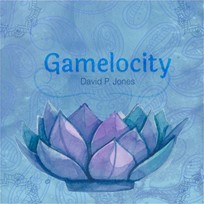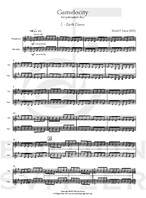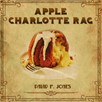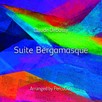
Gamelocity
Composer: David P. Jones
Instrument: Percussion Duo
Level: Advanced
Published: 2015
Price: €25.00
Item details
-
Description +
-
.. Gamelocity a portmanteau of “gamelan” and “velocity”. The opening passage came to me rather quickly and suggested the brilliant gamelan gong kebjar style of Bali. I have not attempted to duplicate the authentic scales, forms or timbres of gamelan. Rather, it was more of a spiritual and stylistic inspiration which seemed natural to me when composing for tuned mallet percussion. The pitch organization actually owes more to Indian raga than the fixed pentatonic scales of gamelan. The movement titles relate as much to musical gestures as they do to emotional images. “Earth Dance” is somewhat grounded by the reiterated drone pitch, whereas “Sky Dance” has a jagged, ascending motive. “Reflecting Pool” is liquid and still...
-
-
Instrumentation +
-
Percussion Duo:
Marimba and Vibraphone
-
-
About the composer +
-
David P. Jones was born on February 10, 1958 in Stockton, California. A former member of the music faculty of Eastern Washington University, he holds a D.M. in Composition from Indiana University, a M.M. in Composition from New England Conservatory, and a B.M. in Composition from the University of Washington. His principal composition teachers have been Don Freund, Eugene O'Brien, Malcolm Peyton, William Bergsma, and William O. Smith. He has also studied jazz with David Baker, Ernie Wilkins, and James Knapp. He joined the faculty of Peninsula College in 2008.
The music of Dr. Jones has received over 300 performances in Paris, Stockholm, Osaka, Quebec City, New York, Boston, Miami, Cleveland, St. Paul, Seattle, San Antonio and many other locations in France, Sweden, Denmark, Belgium, Netherlands, Finland, Poland, Canada, Australia, Japan, Malaysia, Brazil, Venezuela, and the USA. His music has also been featured at many festivals and conferences, including: Tanglewood, Korsholm Music Festival (Finland),Manchester Music Festival (Vermont), New England Music Camp, Society of Composers, MENC, College Music Society, NACWPI, International Trumpet Guild, International Horn Society, International Trombone Association, and the Percussive Arts Society.
Performers have included St. Paul Chamber Orchestra (conducted by Dennis Russell Davies), Seattle Symphony, New England Conservatory Symphony (Robert Spano), Indiana University Symphony, Virginia Intercollegiate Band, New England Conservatory Wind Ensemble (Frank Battisti), Eastman Trombone Choir (John Marcellus), University of Minnesota Trombone Choir, University of Washington Trombone Choir, Bob Curnow Big Band, Indiana University Jazz Ensemble (David Baker), University of Iowa Jazz Ensemble (John Rapson), University of Missouri-Kansas City Jazz Ensemble (Bobby Watson), Cornish College Jazz Orchestra, Marimolin, Marimbolino, Duo Contrastes, PercuDuo, Boston Trombone Quartet, Spokane String Quartet, Le Quatuor Habañera, Ron Barron, Mike Tunnell, Doug Wright, Tim Hudson and many others. Commissioning organizations include Carolina Brass, Seattle Flute Society, Spokane String Quartet, Composers and Improvisers Orchestra, Eastern Washington University, Peninsula College, and Washington State Music Teachers Association. His works are published by Edition Musicales Combre, Gérard Bilaudot Editions (Paris), C. Alan Publications,Radnofsky Couper Editions, Walrus Music and Sierra Music (USA); and recorded on Catalyst/BMG, Nosag (Sweden), Polymnie (France), Summit, Centaur, and Coronet. His music has been broadcast on radio stations throughout the US and in France, Sweden and Australia.
Dr. Jones was named "Composer of the Year" in 1995 by the Washington State Music Teachers Association and has received First Prize in competitions sponsored by Marimolin, International Horn Society, St. Paul Chamber Orchestra, Friends and Enemies of New Music, and New Music for Young Ensembles. He has also received awards from Vandoren Concours International de Composition pour Saxophone, Concorso Intenazionale di Composizione per Banda di Corciano, Abraham Frost Prize for Composition, International Association for the Promotion of the Saxophone, International Trombone Association, Virginia Symposium for New Band Music, as well as fellowships from Artist Trust (1988) and the Washington State Arts Commission (1985).
Active as a dance accompanist for over 25 years, he has worked with Patricia McBride, Violette Verdy, Fernando Bujones, Bruce Wells, Elaine Bauer, Paul Sanasardo, Bill Evans, Mary Anthony, Margaret Jenkins, Ann Reinking, Brenda Buffalino, David Dorfman, Seán Curran, and members of the Martha Graham Dance Company, Joffrey Ballet, American Ballet Theater, New York City Ballet, and Twyla Tharp Dance Company. He also performed with, and wrote for, the Bob Curnow Big Band from 1996-1998 and his big band charts are currently in the repertoire of over fifty bands across the US and in England.
-
-
Reviews +
-
Precussive Notes, November 2016
Percussionists may recognize composer David P. Jones from his popular work for marimba and violin, “Legal Highs,” which was written for the Marimolin duo and has received hundreds of performances. This new duo for keyboard percussion was commissioned by Damien Petitjean, and was recorded by Damien and Philippe Limoge (as Percuduo) on their album Amerikas! (2012, French Polymnie). “Gamelocity” is written in three movements.
According to Jones, “Gamelocity” is a portmanteau of “gamelan” and “velocity.” The first movement, “Earth Dance,” convincingly portrays both of these adjectives, as players must execute a barrage of moving notes at 160 beatsper- minute, in a style that is reminiscent of the Balinese gamelan gong kebjar. This manner of writing works well for these instruments, rooted in the historical keyboard percussive traditions of Bali and Java. A drone pitch on D helps keep things grounded, as do recurring tutti passages. These unison passages are contrasted against sections where the vibraphone takes a dominant melodic role and the marimba establishes harmonic material underneath. More rhythmic variation is given to the vibraphone, which often plays portions of the marimba pattern in the treble register and a sustained drone pitch in the bottom register of the instrument. Both parts are equally challenging however. The middle movement, “Reflecting Pool,” begins with the vibraphonist armed with bow and mallets. The marimbist is instructed to play undulating ripple rolls throughout the movement, varying the speed and intensity as the lines demand.
The middle section is marked “rubato, like an improvisation,” which ultimately leads to an aleatoric/ improvised section for the vibraphonist, while the marimbist continues sparse, recitative-like gestures similar to statements the vibraphone made earlier. Emotionally, this movement is calm and introspective, with a musically glassy exterior. There is much less motion compared to the joyful romp of the outer movements. In that way it’s a welcome respite for the players. The movement ends on an A-flat major chord in first inversion, but with a sustained D natural in the vibraphone. This tritone leaves the movement feeling ultimately unresolved, like there is more to come.
Enter then the opening four notes of “Sky Dance” (G, C, C-sharp, F-sharp), which constitute one of the primary motivic ideas of this final movement. It’s actually a tetrachord often used by Bela Bartok (0, 5, 6, 11). In stark contrast to the tightly centric writing of the first movement, Jones makes use of larger intervallic jumps, always climbing but never quite reaching a resolution. But, as in the first movement, many of the gestures are executed in quasi-unison, but never for such an extended period that the music becomes predictable. The rhythmic language of this movement is always “dancing,” with a good bit of playful metric modulation scattered throughout. The writing is angular and witty, often with an exuberance that reminds one of a Bernstein film score. And with several quick tempo changes, it keeps the listener “up in the air” as to what is coming next.
With “Gamelocity,” Jones has created a work that makes a welcome addition to the marimba/vibraphone genre. Duration of the piece is just under 15 minutes.
—Phillip O’Banion
-
-
Credits +
-
Front cover graphics: Gaia Gomes
Engraving: Johan Svitzer
Printed in Copenhagen, Denmark
Copyright © Edition SVITZER
www.editionsvitzer.com
-





